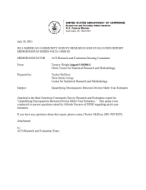
An official website of the United States government
Here’s how you know
Official websites use .gov
A .gov website belongs to an official government organization in the United States.
Secure .gov websites use HTTPS
A lock (
) or https:// means you’ve safely connected to the .gov website. Share sensitive information only on official, secure websites.
-
//
- Census.gov /
- Census Working Papers /
- Quantifying Discrepancies Between Diverse Multi-Year Estimates
Quantifying Discrepancies Between Diverse Multi-Year Estimates
Quantifying Discrepancies Between Diverse Multi-Year Estimates
The rolling sample methodology of the American Community Survey (ACS) introduces temporal distortions, resulting in Multiyear Estimates (MYEs) that measure aggregate activity over three or five years. They cannot be viewed as estimates of the final year, nor of the middle time point of the period; neither can they be viewed as simple averages of single year estimates belonging to the same time span. The U.S. Census Bureau has enunciated this principle forcefully, yet the question remains - in light of the fact that users are likely to ignore official pronouncements - how damaging are these unsanctioned viewpoints? In particular, can one quantify the impact of making such fallacious use of the MYEs? This paper answers these questions positively: yes, it can be quantified, and in general there is fairly serious degradation to the usability of MYEs when applying these faulty interpretations. We first offer a critique of the comparison of diverse MYEs via the published standard errors, and then we discuss a simple, general method based on relative percent discrepancies. This technique is illustrated on the test database of the ACS, from which we draw our general conclusions.
Others in Series
Working Paper
Working Paper
Working Paper
Share
Some content on this site is available in several different electronic formats. Some of the files may require a plug-in or additional software to view.
 Yes
Yes
 No
NoComments or suggestions?


Top

